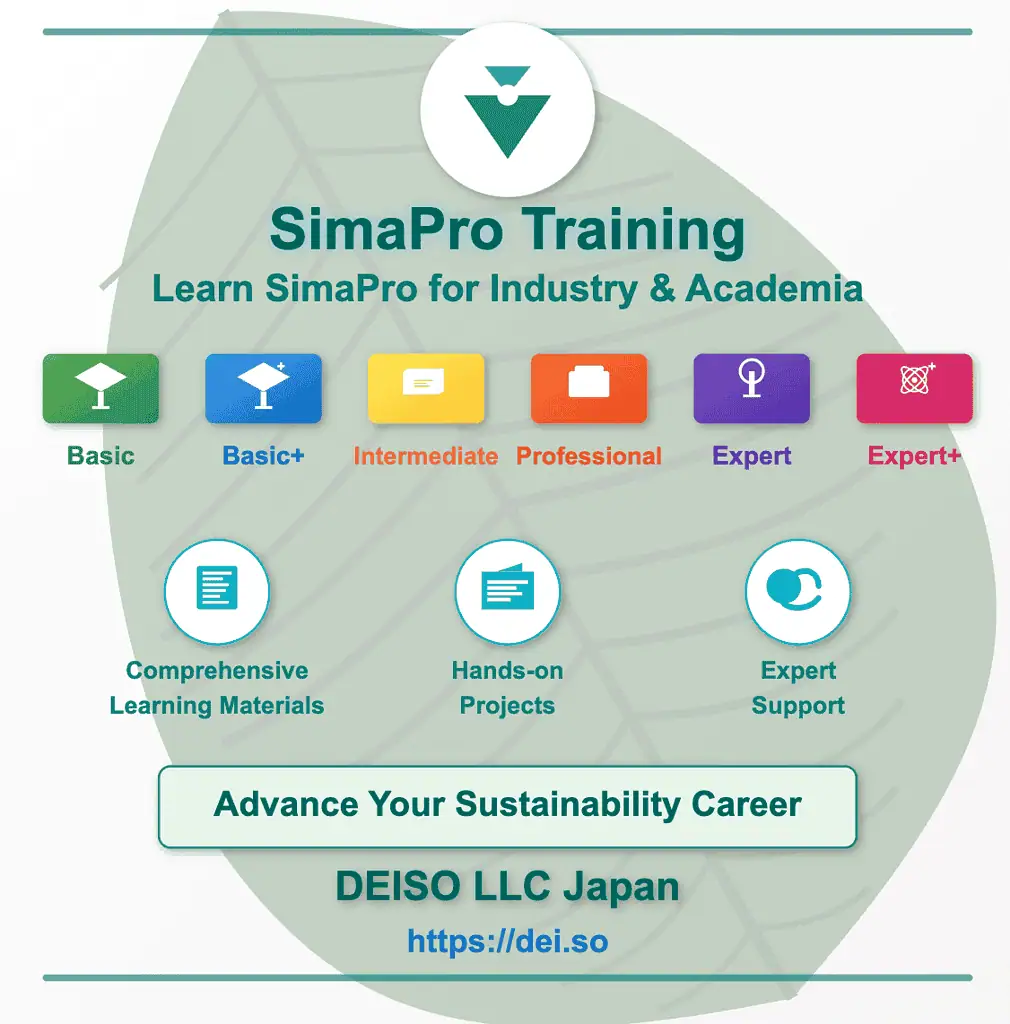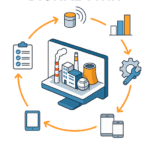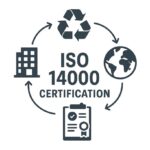SimaPro Training Plan

SimaPro Training: Learn SimaPro for Industry & Academia.
Choose the right plan for your needs—Basic to Basic+, Intermediate, Professional, Expert, and Expert+.
- SimaPro Basic Training: Ideal for students looking to begin their journey with SimaPro.
- SimaPro Basic+ Training: Suitable for students and analysts who want to get started with SimaPro.
- SimaPro Intermediate Training: Designed for students and sustainability analysts.
- SimaPro Professional Training: Recommended for PhD students, sustainability analysts, and environmental engineers.
- SimaPro Expert Training: Best suited for PhD students, eco-designers, sustainability analysts, environmental engineers, academic researchers, and R&D team members.
- SimaPro Expert+ Training: Tailored for independent consultants, firms offering LCA and sustainability consulting, advanced-level researchers, and R&D team members.
Each plan starts at the foundational level and advances to its respective stage. For example, the “Professional” plan begins with no prior knowledge and builds up to a professional level. Similarly, the “Expert” plan starts from the basics and progresses to an expert level.
The “Expert+” plan includes all the training modules from the “Expert” plan, along with advanced-level modules and features that extend beyond the “Expert” level.
This training program is offered remotely (online) via the Zoom app. We offer both one-on-one and group training. Pricing is per participant.
This training program is offered onsite and can be tailored to your company’s location outside Japan. We require a minimum number of participants. Pricing is per attendee. Please contact us for more information.
This off-site training program is conducted at DEISO in Tokyo. We require a minimum number of participants, and pricing is per attendee. Please contact us for more details.
For a comprehensive comparison of remote, on-site, and off-site training, please refer to this page.
The short answer is “No”. You need to sign up for a one-level “plan.” Every plan begins at level ZERO and progresses to a certain level. Based on the comparison table below, you may choose the curriculum and the level you wish to attain. You may, however, sign up for two programs—one now and one later- at a discounted price.
- After your payment is processed, we will send you a proposed training schedule.
- Once you (or your team) approve the schedule, you will receive Zoom invitations via email and a calendar invite for each session.
- Training will then begin as scheduled (on-demand).
Tip for Training Plans Comparison
Move your mouse cursor over any item of a plan with a dashed underline to check and read additional information with the “Feature Tooltip.”
SimaPro Basic
Curriculum & Features
-
English Training Training is provided in English by an expert LCA trainer at the PhD level.
-
Fixable Training Scheduling Regardless of the Time Zone.
-
Basic Training Module LCA Method of 3 Hours Optional: A basic training module on the Life Cycle Assessment (LCA) method of 3 hours is aligned with the training beads for SimaPro.
-
Basic Training on the ecoinvent database of 3 hours Optional: Basic Training on the ecoinvent database (the core database in SimaPro). The ecoinvent database is vital in the LCA industry and is widely used. Learn in this module about ecoinvent unit processes, system processes, the ecoinvent three model systems (Allocation, cut-off by classification, Allocation at the point of substitution, Substitution, consequential, long-term, and Allocation, cut-off, EN15804), and the different types of each process "market, transformation, and infrastructure). Simplifying the intricacies of the ecoinvent database, this module acquaints you with its crucial components, enabling a comprehensive understanding.
-
Extensive Training Intensive training for complete program understanding.
-
Accelerated Learning Approach Active learning approach accelerates understanding by tailoring instruction to individual styles, using discussions, interactive elements, demonstrations, practical examples, assignments, and trainee feedback.
-
Remote (Online) or in Person Choose your DEISO training delivery: online (remote), at your company's location in Japan, or international locations (overseas). Prices vary for each model, and a minimum number of trainees is required except for online training, which can be one-to-one- or one-to-group. A single trainee is sufficient for online training to deliver the chosen training program.
-
Training at the Client's Physical Location Outside of Japan Choose your DEISO training delivery: online (remote), at your company's location in Japan, or international locations (overseas). Prices vary for each model, and a minimum number of trainees is required except for online training, which can be one-to-one- or one-to-group. A single trainee is sufficient for online training to deliver the chosen training program.
-
In-Person Training at the Client's Physical Location in Japan A minimum number of trainees is required. Please contact us.
-
Case Studies: 1
-
Waste Management Case Study with Global Parameters A parameterized and complete waste management case study of downstream waste "municipal solid waste management (MSW).
-
Getting Started with SimaPro A detailed walkthrough of the SimaPro user-friendly interface and its functions menu is provided. The software panels ("panel-by-panel") are explained in detail. This module also covers common tasks such as creating new projects, opening existing ones, and exploring SimaPro's various functions. This includes understanding interface options, tools, data organization, and their overall structure. Productivity tips are also provided for using the main interface.
-
Basic SimaPro Modeling Principles Understand the SimaPro Modeling Principles, as these principles can differ between software platforms.
-
Advanced SimaPro Modeling Principles Understand the SimaPro Modeling Principles, as these principles can differ between software platforms.
-
Understanding Process Documentation It's strongly advised to read process documentation before selecting it for a certain project. Simply relying on process names without consulting documentation is not recommended. Users are expected to carefully assess process documentation to determine its suitability for the specific case study under analysis. This module will cover effectively reading process documentation and identifying key information that should always be verified.
-
Process Search and Filters Discover techniques for locating processes required for your project using three methods: filtering and global search, and navigating the process hierarchy. Understand the distinct advantages of each approach and when to utilize them to enhance productivity and streamline access to processes.
-
Process Input/Output Mastering process input and output is crucial for comprehending the material and energy inputs and other inputs of each process, along with its main product and by-products of the outputs. This module will delve into understanding emissions to and from nature and the technosphere and emissions mediums such as water, air, and soil. This training module will cover the practical application of these concepts to SimaPro processes.
-
Process Edit Gain proficiency in editing existing processes within SimaPro. Discover techniques for copying processes and executing various manipulation and editing tasks.
-
Basic: Unit Process v.s. System Process ecoinvent database serves as the core of SimaPro, providing "Unit Process" and "System Process" options within each of its three system models, functioning as three "3 databases" generating distinct results. Typically, databases like ecoinvent offer two process types: Unit Process and System Process. This module delves into each type's theoretical, technical, and mathematical aspects, explaining their differences and the usage scenarios. Further, this module aims to simplify the complexity of these concepts for the trainee(s).
-
Advanced: Unit Process v.s. System Process ecoinvent database serves as the core of SimaPro, providing "Unit Process" and "System Process" options within each of its three system models, functioning as three "3 databases" generating distinct results. Typically, databases like ecoinvent offer two process types: Unit Process and System Process. This module delves into each type's theoretical, technical, and mathematical aspects, explaining their differences and the usage scenarios. Further, this module aims to simplify the complexity of these concepts for the trainee(s).
-
The Use Market Process & Transformation Process The ecoinvent database in SimaPro features three types of processes: "Unit Process," "System Process," and "Market Process" under the "Unit" and "System" processes groups. You will be guided on utilizing each type according to specific project requirements and scenarios.
-
Cut Off Criteria
-
Basic Impact Assessment
-
Advanced Impact Assessment
-
Basic Inventory Analysis
-
Advanced Inventory Analysis
-
Basic Network Analysis
-
Advanced Network Analysis
-
Basic Process Contribution
-
Advanced Process Contribution
-
Basic Hotspot (Weak-Point) Analysis with MS Excel Hotspot analysis, a fundamental aspect of Life Cycle Assessment (LCA), aids in pinpointing weak points or areas of concern within a product's life cycle. By identifying these hotspots, LCA practitioners can prioritize efforts to mitigate environmental impacts and optimize sustainability. This analysis enables stakeholders/LCA analysts to focus resources on improving processes or materials that contribute most significantly to ecological burdens, leading to more informed decision-making and ultimately fostering the development of more sustainable products and systems.
-
Advanced Hotspot (Weak-Point) Analysis with MS Excel Hotspot analysis, a fundamental aspect of Life Cycle Assessment (LCA), aids in pinpointing weak points or areas of concern within a product's life cycle. By identifying these hotspots, LCA practitioners can prioritize efforts to mitigate environmental impacts and optimize sustainability. This analysis enables stakeholders/LCA analysts to focus resources on improving processes or materials that contribute most significantly to ecological burdens, leading to more informed decision-making and ultimately fostering the development of more sustainable products and systems.
-
Define the Uncertainty of Your Data Discover how to quantify the uncertainty inherent in the foreground data you input for modeling specific case studies or projects. Understand how these uncertainties can be incorporated into the final LCA results, ensuring a more comprehensive and accurate evaluation of environmental impacts.
-
Building Custom Processes Gain skills in creating custom processes for the Life Cycle Inventory (LCI), utilizing background data from literature, reports, and other sources. Learn how to create processes that accurately represent your specific emission factor data, enabling a tailored and precise evaluation within your LCA.
-
Model's Local Parameters Discover how to parameterize your SimaPro model using local parameters to accommodate potential future data changes. Facilitate scenario analysis and development, support eco-design modeling, and compare different products and technologies. Learn how to incorporate these parameters into your models and update them as new data becomes available, enhancing flexibility and professionalism while saving valuable time.
-
Model's Global Parameters Discover how to parameterize your SimaPro model using global parameters to accommodate potential future data changes. Facilitate scenario analysis and development, support eco-design modeling, and compare different products and technologies. Learn how to incorporate these parameters into your models and update them as new data becomes available, enhancing flexibility and professionalism while saving valuable time.
-
Parameters Calculations
-
Converting a Model to a System Process (LCI) Results
-
Process Technology Analysis Acquire the skills to conduct comprehensive "Process Technology Analysis" using SimaPro and Microsoft Excel, enabling the derivation of precise conclusions to inform decision-making effectively.
-
Advanced Process Technology Analysis Acquire the skills to conduct comprehensive "Process Technology Analysis" using SimaPro and Microsoft Excel, enabling the derivation of precise conclusions to inform decision-making effectively.
-
Basic Dashboards, Calculations, and Viewing Results Gain proficiency in viewing and analyzing the final collations of your model results. Master the skills required to navigate, comprehend, and effectively utilize each results dashboard. This module focuses primarily on the fourth phase of the LCA: interpretation of the final results.
-
Advanced Dashboards, Calculations, and Viewing Results Gain proficiency in viewing and analyzing the final collations of your model results. Master the skills required to navigate, comprehend, and effectively utilize each results dashboard. This module focuses primarily on the fourth phase of the LCA: interpretation of the final results.
-
Graphs Color Editing/Formatting/Export
-
CO2/CH4 Emissions Anlysis Learn to analyze the two emissions contributing to climate change and product carbon footprint assessment: CO2 and CH4 emissions analysis.
-
GHG Emissions Learn how to conduct a comprehensive climate change assessment using various Life Cycle Impact Assessment (LCIA) methods.
-
Carbon Footprint Calculation
-
Water Footprints Calculation
-
Basic: Export and Manipulate SimaPro Results to Excel
-
Advanced: Export and Manipulate SimaPro Results to Excel
-
Basic Life Cycle Impact Assessment (LCIA) Methods Training LCA results can be carried out at the midpoint level, including environmental impact categories such as "climate change," "acidification potential," "human health potential," etc. These categories (15+ on average based on the LCIA method) are called "midpoint impacts."
-
Advanced Life Cycle Impact Assessment (LCIA) Methods Training
-
Basic Mid-Point Modeling LCA results can be carried out at the midpoint level, including environmental impact categories such as "climate change," "acidification potential," "human health potential," etc. These categories (15+ on average based on the LCIA method) are called "midpoint impacts."
-
Basic End-Point Modeling LCA results can be carried out also at the "endpoint" level where the midpoint impact categories (15+ on average) can be aggregated to single 3-4 indicators such as "damage to the ecosystem," damage to health," and damage to resources." This aggregation is called "endpoint modeling."
-
Advanced End-Point Modeling LCA results can be carried out also at the "endpoint" level where the midpoint impact categories (15+ on average) can be aggregated to single 3-4 indicators such as "damage to the ecosystem," damage to health," and damage to resources." This aggregation is called "endpoint modeling."
-
Advanced End-Point Modeling LCA results can be carried out also at the "endpoint" level where the midpoint impact categories (15+ on average) can be aggregated to single 3-4 indicators such as "damage to the ecosystem," damage to health," and damage to resources." This aggregation is called "endpoint modeling."
-
Basic Cradle-to-Gate Modeling
-
Advanced Cradle-to-Gate Modeling
-
Gate-to-Gate Modeling
-
Cate-to-Grave Modeling
-
Basic: Cradle-to-Grave Modelling (The complete Life Cycle)
-
Advanced: Cradle-to-Grave Modelling (The complete Life Cycle)
-
Basic Life Cycles Modeling (Production, Transportation, Use, waste Reuse, etc.)
-
Advanced Life Cycles Modeling (Production, Transportation, Use, waste Reuse, etc.)
-
Professional Modeling Techniques
-
Compare Alternative Products/Technologies
-
Allocation Principles and Calculations
-
Monte Carlo Analysis/Uncertainty Theory Monte Carlo simulation, a key aspect of uncertainty analysis in LCA, involves repeatedly running models using random input values from specified probability distributions. This method accounts for uncertainties in LCA inputs and yields probability distributions of outputs, providing a comprehensive understanding of potential outcomes. By quantifying uncertainties, Monte Carlo simulation enhances the reliability of LCA results, facilitates informed decision-making, and improves the accuracy of environmental assessments, ultimately leading to more robust and defensible conclusions.
-
Basic: Performing Monte Carlo Analysis/Uncertainty Analysis
-
Advanced: Performing Monte Carlo Analysis/Uncertainty Analysis
-
Sensitivity Analysis with SimaPro Parameters & Excel Sensitivity analysis in LCA evaluates the impact of varying parameters on study outcomes, identifying influential factors and their effects on the results' reliability. Sensitivity analysis enhances the credibility and robustness of LCA findings by systematically testing input variables, such as data uncertainties or methodological choices. It enables stakeholders to understand the significance of assumptions and uncertainties, aiding informed decision-making in sustainable product development and policy formulation.
-
Credit Modeling of Energy (Model Energy Recovery Power & Thermal)
-
Credit Modeling of Materials (Recycling of Materials)
-
Training on "SimaPro Report Maker" Addon Optional
-
SimaPro Assemblies Modeling
-
SimaPro Disassembles Modeling
-
SimaPro Waste Scenario Modeling
-
Scenario & Eco-Design Modeling
-
Database Management
-
Database and Projects Backup
-
Databases Maintenance
-
Updating, Maintaining & Troubleshooting SimaPro Optional
-
Professional Tips & Ticks for Professional use of SimaPro
-
Expert Tips & Ticks for Professional use of SimaPro
SimaPro Basic+
Curriculum & Features
-
English Training Training is provided in English by an expert LCA trainer at the PhD level.
-
Fixable Training Scheduling Regardless of the Time Zone.
-
Basic Training Module LCA Method of 3 Hours Optional: A basic training module on the Life Cycle Assessment (LCA) method of 3 hours is aligned with the training beads for SimaPro.
-
Basic Training on the ecoinvent database of 3 hours Optional: Basic Training on the ecoinvent database (the core database in SimaPro). The ecoinvent database is vital in the LCA industry and is widely used. Learn in this module about ecoinvent unit processes, system processes, the ecoinvent three model systems (Allocation, cut-off by classification, Allocation at the point of substitution, Substitution, consequential, long-term, and Allocation, cut-off, EN15804), and the different types of each process "market, transformation, and infrastructure). Simplifying the intricacies of the ecoinvent database, this module acquaints you with its crucial components, enabling a comprehensive understanding.
-
Extensive Training Intensive training for complete program understanding.
-
Accelerated Learning Approach Active learning approach accelerates understanding by tailoring instruction to individual styles, using discussions, interactive elements, demonstrations, practical examples, assignments, and trainee feedback.
-
Remote (Online) or in Person Choose your DEISO training delivery: online (remote), at your company's location in Japan, or international locations (overseas). Prices vary for each model, and a minimum number of trainees is required except for online training, which can be one-to-one- or one-to-group. A single trainee is sufficient for online training to deliver the chosen training program.
-
Training at the Client's Physical Location Outside of Japan Choose your DEISO training delivery: online (remote), at your company's location in Japan, or international locations (overseas). Prices vary for each model, and a minimum number of trainees is required except for online training, which can be one-to-one- or one-to-group. A single trainee is sufficient for online training to deliver the chosen training program.
-
In-Person Training at the Client's Physical Location in Japan A minimum number of trainees is required. Please contact us.
-
Case Studies: 2
-
Waste Management Case Study with Global Parameters A parameterized and complete waste management case study of downstream waste "municipal solid waste management (MSW).
-
Getting Started with SimaPro A detailed walkthrough of the SimaPro user-friendly interface and its functions menu is provided. The software panels ("panel-by-panel") are explained in detail. This module also covers common tasks such as creating new projects, opening existing ones, and exploring SimaPro's various functions. This includes understanding interface options, tools, data organization, and their overall structure. Productivity tips are also provided for using the main interface.
-
Basic SimaPro Modeling Principles Understand the SimaPro Modeling Principles, as these principles can differ between software platforms.
-
Advanced SimaPro Modeling Principles Understand the SimaPro Modeling Principles, as these principles can differ between software platforms.
-
Understanding Process Documentation It's strongly advised to read process documentation before selecting it for a certain project. Simply relying on process names without consulting documentation is not recommended. Users are expected to carefully assess process documentation to determine its suitability for the specific case study under analysis. This module will cover effectively reading process documentation and identifying key information that should always be verified.
-
Process Search and Filters Discover techniques for locating processes required for your project using three methods: filtering and global search, and navigating the process hierarchy. Understand the distinct advantages of each approach and when to utilize them to enhance productivity and streamline access to processes.
-
Process Input/Output Mastering process input and output is crucial for comprehending the material and energy inputs and other inputs of each process, along with its main product and by-products of the outputs. This module will delve into understanding emissions to and from nature and the technosphere and emissions mediums such as water, air, and soil. This training module will cover the practical application of these concepts to SimaPro processes.
-
Process Edit Gain proficiency in editing existing processes within SimaPro. Discover techniques for copying processes and executing various manipulation and editing tasks.
-
Basic: Unit Process v.s. System Process ecoinvent database serves as the core of SimaPro, providing "Unit Process" and "System Process" options within each of its three system models, functioning as three "3 databases" generating distinct results. Typically, databases like ecoinvent offer two process types: Unit Process and System Process. This module delves into each type's theoretical, technical, and mathematical aspects, explaining their differences and the usage scenarios. Further, this module aims to simplify the complexity of these concepts for the trainee(s).
-
Advanced: Unit Process v.s. System Process ecoinvent database serves as the core of SimaPro, providing "Unit Process" and "System Process" options within each of its three system models, functioning as three "3 databases" generating distinct results. Typically, databases like ecoinvent offer two process types: Unit Process and System Process. This module delves into each type's theoretical, technical, and mathematical aspects, explaining their differences and the usage scenarios. Further, this module aims to simplify the complexity of these concepts for the trainee(s).
-
The Use Market Process & Transformation Process The ecoinvent database in SimaPro features three types of processes: "Unit Process," "System Process," and "Market Process" under the "Unit" and "System" processes groups. You will be guided on utilizing each type according to specific project requirements and scenarios.
-
Cut Off Criteria
-
Basic Impact Assessment
-
Advanced Impact Assessment
-
Basic Inventory Analysis
-
Advanced Inventory Analysis
-
Basic Network Analysis
-
Advanced Network Analysis
-
Basic Process Contribution
-
Advanced Process Contribution
-
Basic Hotspot (Weak-Point) Analysis with MS Excel Hotspot analysis, a fundamental aspect of Life Cycle Assessment (LCA), aids in pinpointing weak points or areas of concern within a product's life cycle. By identifying these hotspots, LCA practitioners can prioritize efforts to mitigate environmental impacts and optimize sustainability. This analysis enables stakeholders/LCA analysts to focus resources on improving processes or materials that contribute most significantly to ecological burdens, leading to more informed decision-making and ultimately fostering the development of more sustainable products and systems.
-
Advanced Hotspot (Weak-Point) Analysis with MS Excel Hotspot analysis, a fundamental aspect of Life Cycle Assessment (LCA), aids in pinpointing weak points or areas of concern within a product's life cycle. By identifying these hotspots, LCA practitioners can prioritize efforts to mitigate environmental impacts and optimize sustainability. This analysis enables stakeholders/LCA analysts to focus resources on improving processes or materials that contribute most significantly to ecological burdens, leading to more informed decision-making and ultimately fostering the development of more sustainable products and systems.
-
Define the Uncertainty of Your Data Discover how to quantify the uncertainty inherent in the foreground data you input for modeling specific case studies or projects. Understand how these uncertainties can be incorporated into the final LCA results, ensuring a more comprehensive and accurate evaluation of environmental impacts.
-
Building Custom Processes Gain skills in creating custom processes for the Life Cycle Inventory (LCI), utilizing background data from literature, reports, and other sources. Learn how to create processes that accurately represent your specific emission factor data, enabling a tailored and precise evaluation within your LCA.
-
Model's Local Parameters Discover how to parameterize your SimaPro model using local parameters to accommodate potential future data changes. Facilitate scenario analysis and development, support eco-design modeling, and compare different products and technologies. Learn how to incorporate these parameters into your models and update them as new data becomes available, enhancing flexibility and professionalism while saving valuable time.
-
Model's Global Parameters Discover how to parameterize your SimaPro model using global parameters to accommodate potential future data changes. Facilitate scenario analysis and development, support eco-design modeling, and compare different products and technologies. Learn how to incorporate these parameters into your models and update them as new data becomes available, enhancing flexibility and professionalism while saving valuable time.
-
Parameters Calculations
-
Converting a Model to a System Process (LCI) Results
-
Process Technology Analysis Acquire the skills to conduct comprehensive "Process Technology Analysis" using SimaPro and Microsoft Excel, enabling the derivation of precise conclusions to inform decision-making effectively.
-
Advanced Process Technology Analysis Acquire the skills to conduct comprehensive "Process Technology Analysis" using SimaPro and Microsoft Excel, enabling the derivation of precise conclusions to inform decision-making effectively.
-
Basic Dashboards, Calculations, and Viewing Results Gain proficiency in viewing and analyzing the final collations of your model results. Master the skills required to navigate, comprehend, and effectively utilize each results dashboard. This module focuses primarily on the fourth phase of the LCA: interpretation of the final results.
-
Advanced Dashboards, Calculations, and Viewing Results Gain proficiency in viewing and analyzing the final collations of your model results. Master the skills required to navigate, comprehend, and effectively utilize each results dashboard. This module focuses primarily on the fourth phase of the LCA: interpretation of the final results.
-
Graphs Color Editing/Formatting/Export
-
CO2/CH4 Emissions Anlysis Learn to analyze the two emissions contributing to climate change and product carbon footprint assessment: CO2 and CH4 emissions analysis.
-
GHG Emissions Learn how to conduct a comprehensive climate change assessment using various Life Cycle Impact Assessment (LCIA) methods.
-
Carbon Footprint Calculation
-
Water Footprints Calculation
-
Basic: Export and Manipulate SimaPro Results to Excel
-
Advanced: Export and Manipulate SimaPro Results to Excel
-
Basic Life Cycle Impact Assessment (LCIA) Methods Training
-
Advanced Life Cycle Impact Assessment (LCIA) Methods Training
-
Basic Mid-Point Modeling LCA results can be carried out at the midpoint level, including environmental impact categories such as "climate change," "acidification potential," "human health potential," etc. These categories (15+ on average based on the LCIA method) are called "midpoint impacts."
-
Advanced Mid-Point Modeling LCA results can be carried out at the midpoint level, including environmental impact categories such as "climate change," "acidification potential," "human health potential," etc. These categories (15+ on average based on the LCIA method) are called "midpoint impacts."
-
Basic End-Point Modeling LCA results can be carried out also at the "endpoint" level where the midpoint impact categories (15+ on average) can be aggregated to single 3-4 indicators such as "damage to the ecosystem," damage to health," and damage to resources." This aggregation is called "endpoint modeling."
-
Advanced End-Point Modeling LCA results can be carried out also at the "endpoint" level where the midpoint impact categories (15+ on average) can be aggregated to single 3-4 indicators such as "damage to the ecosystem," damage to health," and damage to resources." This aggregation is called "endpoint modeling."
-
Basic Cradle-to-Gate Modeling
-
Advanced Cradle-to-Gate Modeling
-
Gate-to-Gate Modeling
-
Cate-to-Grave Modeling
-
Basic: Cradle-to-Grave Modelling (The complete Life Cycle)
-
Advanced: Cradle-to-Grave Modelling (The complete Life Cycle)
-
Basic Life Cycles Modeling (Production, Transportation, Use, waste Reuse, etc.)
-
Advanced Life Cycles Modeling (Production, Transportation, Use, waste Reuse, etc.)
-
Professional Modeling Techniques
-
Compare Alternative Products/Technologies
-
Allocation Principles and Calculations
-
Monte Carlo Analysis/Uncertainty Theory Monte Carlo simulation, a key aspect of uncertainty analysis in LCA, involves repeatedly running models using random input values from specified probability distributions. This method accounts for uncertainties in LCA inputs and yields probability distributions of outputs, providing a comprehensive understanding of potential outcomes. By quantifying uncertainties, Monte Carlo simulation enhances the reliability of LCA results, facilitates informed decision-making, and improves the accuracy of environmental assessments, ultimately leading to more robust and defensible conclusions.
-
Basic: Performing Monte Carlo Analysis/Uncertainty Analysis
-
Advanced: Performing Monte Carlo Analysis/Uncertainty Analysis
-
Sensitivity Analysis with SimaPro Parameters & Excel Sensitivity analysis in LCA evaluates the impact of varying parameters on study outcomes, identifying influential factors and their effects on the results' reliability. Sensitivity analysis enhances the credibility and robustness of LCA findings by systematically testing input variables, such as data uncertainties or methodological choices. It enables stakeholders to understand the significance of assumptions and uncertainties, aiding informed decision-making in sustainable product development and policy formulation.
-
Credit Modeling of Energy (Model Energy Recovery Power & Thermal)
-
Credit Modeling of Materials (Recycling of Materials)
-
Training on "SimaPro Report Maker" Addon Optional
-
SimaPro Assemblies Modeling
-
SimaPro Disassembles Modeling
-
SimaPro Waste Scenario Modeling
-
Scenario & Eco-Design Modeling
-
Database Management
-
Database and Projects Backup
-
Databases Maintenance
-
Updating, Maintaining & Troubleshooting SimaPro Optional
-
Professional Tips & Ticks for Professional use of SimaPro
-
Expert Tips & Ticks for Professional use of SimaPro
SimaPro Intermediate
Curriculum & Features
-
English Training Training is provided in English by an expert LCA trainer at the PhD level.
-
Fixable Training Scheduling Regardless of the Time Zone.
-
Basic Training Module LCA Method of 3 Hours Optional: A basic training module on the Life Cycle Assessment (LCA) method of 3 hours is aligned with the training beads for SimaPro.
-
Basic Training on the ecoinvent database of 3 hours Optional: Basic Training on the ecoinvent database (the core database in SimaPro). The ecoinvent database is vital in the LCA industry and is widely used. Learn in this module about ecoinvent unit processes, system processes, the ecoinvent three model systems (Allocation, cut-off by classification, Allocation at the point of substitution, Substitution, consequential, long-term, and Allocation, cut-off, EN15804), and the different types of each process "market, transformation, and infrastructure). Simplifying the intricacies of the ecoinvent database, this module acquaints you with its crucial components, enabling a comprehensive understanding.
-
Extensive Training Intensive training for complete program understanding.
-
Accelerated Learning Approach Active learning approach accelerates understanding by tailoring instruction to individual styles, using discussions, interactive elements, demonstrations, practical examples, assignments, and trainee feedback.
-
Remote (Online) or in Person Choose your DEISO training delivery: online (remote), at your company's location in Japan, or international locations (overseas). Prices vary for each model, and a minimum number of trainees is required except for online training, which can be one-to-one- or one-to-group. A single trainee is sufficient for online training to deliver the chosen training program.
-
Training at the Client's Physical Location Outside of Japan Choose your DEISO training delivery: online (remote), at your company's location in Japan, or international locations (overseas). Prices vary for each model, and a minimum number of trainees is required except for online training, which can be one-to-one- or one-to-group. A single trainee is sufficient for online training to deliver the chosen training program.
-
In-Person Training at the Client's Physical Location in Japan A minimum number of trainees is required. Please contact us.
-
Case Studies: 2
-
Waste Management Case Study with Global Parameters A parameterized and complete waste management case study of downstream waste "municipal solid waste management (MSW).
-
Getting Started with SimaPro A detailed walkthrough of the SimaPro user-friendly interface and its functions menu is provided. The software panels ("panel-by-panel") are explained in detail. This module also covers common tasks such as creating new projects, opening existing ones, and exploring SimaPro's various functions. This includes understanding interface options, tools, data organization, and their overall structure. Productivity tips are also provided for using the main interface.
-
Basic SimaPro Modeling Principles Understand the SimaPro Modeling Principles, as these principles can differ between software platforms.
-
Advanced SimaPro Modeling Principles Understand the SimaPro Modeling Principles, as these principles can differ between software platforms.
-
Understanding Process Documentation It's strongly advised to read process documentation before selecting it for a certain project. Simply relying on process names without consulting documentation is not recommended. Users are expected to carefully assess process documentation to determine its suitability for the specific case study under analysis. This module will cover effectively reading process documentation and identifying key information that should always be verified.
-
Process Search and Filters Discover techniques for locating processes required for your project using three methods: filtering and global search, and navigating the process hierarchy. Understand the distinct advantages of each approach and when to utilize them to enhance productivity and streamline access to processes.
-
Process Input/Output Mastering process input and output is crucial for comprehending the material and energy inputs and other inputs of each process, along with its main product and by-products of the outputs. This module will delve into understanding emissions to and from nature and the technosphere and emissions mediums such as water, air, and soil. This training module will cover the practical application of these concepts to SimaPro processes.
-
Process Edit Gain proficiency in editing existing processes within SimaPro. Discover techniques for copying processes and executing various manipulation and editing tasks.
-
Basic: Unit Process v.s. System Process ecoinvent database serves as the core of SimaPro, providing "Unit Process" and "System Process" options within each of its three system models, functioning as three "3 databases" generating distinct results. Typically, databases like ecoinvent offer two process types: Unit Process and System Process. This module delves into each type's theoretical, technical, and mathematical aspects, explaining their differences and the usage scenarios. Further, this module aims to simplify the complexity of these concepts for the trainee(s).
-
Advanced: Unit Process v.s. System Process ecoinvent database serves as the core of SimaPro, providing "Unit Process" and "System Process" options within each of its three system models, functioning as three "3 databases" generating distinct results. Typically, databases like ecoinvent offer two process types: Unit Process and System Process. This module delves into each type's theoretical, technical, and mathematical aspects, explaining their differences and the usage scenarios. Further, this module aims to simplify the complexity of these concepts for the trainee(s).
-
The Use Market Process & Transformation Process The ecoinvent database in SimaPro features three types of processes: "Unit Process," "System Process," and "Market Process" under the "Unit" and "System" processes groups. You will be guided on utilizing each type according to specific project requirements and scenarios.
-
Cut Off Criteria
-
Basic Impact Assessment
-
Advanced Impact Assessment
-
Basic Inventory Analysis
-
Advanced Inventory Analysis
-
Basic Network Analysis
-
Advanced Network Analysis
-
Basic Process Contribution
-
Advanced Process Contribution
-
Basic Hotspot (Weak-Point) Analysis with MS Excel Hotspot analysis, a fundamental aspect of Life Cycle Assessment (LCA), aids in pinpointing weak points or areas of concern within a product's life cycle. By identifying these hotspots, LCA practitioners can prioritize efforts to mitigate environmental impacts and optimize sustainability. This analysis enables stakeholders/LCA analysts to focus resources on improving processes or materials that contribute most significantly to ecological burdens, leading to more informed decision-making and ultimately fostering the development of more sustainable products and systems.
-
Advanced Hotspot (Weak-Point) Analysis with MS Excel Hotspot analysis, a fundamental aspect of Life Cycle Assessment (LCA), aids in pinpointing weak points or areas of concern within a product's life cycle. By identifying these hotspots, LCA practitioners can prioritize efforts to mitigate environmental impacts and optimize sustainability. This analysis enables stakeholders/LCA analysts to focus resources on improving processes or materials that contribute most significantly to ecological burdens, leading to more informed decision-making and ultimately fostering the development of more sustainable products and systems.
-
Define the Uncertainty of Your Data Discover how to quantify the uncertainty inherent in the foreground data you input for modeling specific case studies or projects. Understand how these uncertainties can be incorporated into the final LCA results, ensuring a more comprehensive and accurate evaluation of environmental impacts.
-
Building Custom Processes Gain skills in creating custom processes for the Life Cycle Inventory (LCI), utilizing background data from literature, reports, and other sources. Learn how to create processes that accurately represent your specific emission factor data, enabling a tailored and precise evaluation within your LCA.
-
Model's Local Parameters Discover how to parameterize your SimaPro model using local parameters to accommodate potential future data changes. Facilitate scenario analysis and development, support eco-design modeling, and compare different products and technologies. Learn how to incorporate these parameters into your models and update them as new data becomes available, enhancing flexibility and professionalism while saving valuable time.
-
Model's Global Parameters Discover how to parameterize your SimaPro model using global parameters to accommodate potential future data changes. Facilitate scenario analysis and development, support eco-design modeling, and compare different products and technologies. Learn how to incorporate these parameters into your models and update them as new data becomes available, enhancing flexibility and professionalism while saving valuable time.
-
Parameters Calculations
-
Converting a Model to a System Process (LCI) Results
-
Process Technology Analysis Acquire the skills to conduct comprehensive "Process Technology Analysis" using SimaPro and Microsoft Excel, enabling the derivation of precise conclusions to inform decision-making effectively.
-
Advanced Process Technology Analysis Acquire the skills to conduct comprehensive "Process Technology Analysis" using SimaPro and Microsoft Excel, enabling the derivation of precise conclusions to inform decision-making effectively.
-
Basic Dashboards, Calculations, and Viewing Results Gain proficiency in viewing and analyzing the final collations of your model results. Master the skills required to navigate, comprehend, and effectively utilize each results dashboard. This module focuses primarily on the fourth phase of the LCA: interpretation of the final results.
-
Advanced Dashboards, Calculations, and Viewing Results Gain proficiency in viewing and analyzing the final collations of your model results. Master the skills required to navigate, comprehend, and effectively utilize each results dashboard. This module focuses primarily on the fourth phase of the LCA: interpretation of the final results.
-
Graphs Color Editing/Formatting/Export
-
CO2/CH4 Emissions Anlysis Learn to analyze the two emissions contributing to climate change and product carbon footprint assessment: CO2 and CH4 emissions analysis.
-
GHG Emissions Learn how to conduct a comprehensive climate change assessment using various Life Cycle Impact Assessment (LCIA) methods.
-
Carbon Footprint Calculation
-
Water Footprints Calculation
-
Basic: Export and Manipulate SimaPro Results to Excel
-
Advanced: Export and Manipulate SimaPro Results to Excel
-
Basic Life Cycle Impact Assessment (LCIA) Methods Training
-
Advanced Life Cycle Impact Assessment (LCIA) Methods Training
-
Basic Mid-Point Modeling LCA results can be carried out at the midpoint level, including environmental impact categories such as "climate change," "acidification potential," "human health potential," etc. These categories (15+ on average based on the LCIA method) are called "midpoint impacts."
-
Advanced Mid-Point Modeling LCA results can be carried out at the midpoint level, including environmental impact categories such as "climate change," "acidification potential," "human health potential," etc. These categories (15+ on average based on the LCIA method) are called "midpoint impacts."
-
Basic End-End Modeling LCA results can be carried out also at the "endpoint" level where the midpoint impact categories (15+ on average) can be aggregated to single 3-4 indicators such as "damage to the ecosystem," damage to health," and damage to resources." This aggregation is called "endpoint modeling."
-
Advanced End-Point Modeling LCA results can be carried out also at the "endpoint" level where the midpoint impact categories (15+ on average) can be aggregated to single 3-4 indicators such as "damage to the ecosystem," damage to health," and damage to resources." This aggregation is called "endpoint modeling."
-
Basic Cradle-to-Gate Modeling
-
Advanced Cradle-to-Gate Modeling
-
Gate-to-Gate Modeling
-
Cate-to-Grave Modeling
-
Basic: Cradle-to-Grave Modelling (The complete Life Cycle)
-
Advanced: Cradle-to-Grave Modelling (The complete Life Cycle)
-
Basic Life Cycles Modeling (Production, Transportation, Use, waste Reuse, etc.)
-
Advanced Life Cycles Modeling (Production, Transportation, Use, waste Reuse, etc.)
-
Professional Modeling Techniques
-
Compare Alternative Products/Technologies
-
Allocation Principles and Calculations
-
Monte Carlo Analysis/Uncertainty Theory Monte Carlo simulation, a key aspect of uncertainty analysis in LCA, involves repeatedly running models using random input values from specified probability distributions. This method accounts for uncertainties in LCA inputs and yields probability distributions of outputs, providing a comprehensive understanding of potential outcomes. By quantifying uncertainties, Monte Carlo simulation enhances the reliability of LCA results, facilitates informed decision-making, and improves the accuracy of environmental assessments, ultimately leading to more robust and defensible conclusions.
-
Basic: Performing Monte Carlo Analysis/Uncertainty Analysis
-
Advanced: Performing Monte Carlo Analysis/Uncertainty Analysis
-
Sensitivity Analysis with SimaPro Parameters & Excel Sensitivity analysis in LCA evaluates the impact of varying parameters on study outcomes, identifying influential factors and their effects on the results' reliability. Sensitivity analysis enhances the credibility and robustness of LCA findings by systematically testing input variables, such as data uncertainties or methodological choices. It enables stakeholders to understand the significance of assumptions and uncertainties, aiding informed decision-making in sustainable product development and policy formulation.
-
Credit Modeling of Energy (Model Energy Recovery Power & Thermal)
-
Credit Modeling of Materials (Recycling of Materials)
-
Training on "SimaPro Report Maker" Addon Optional
-
SimaPro Assemblies Modeling
-
SimaPro Disassembles Modeling
-
SimaPro Waste Scenario Modeling
-
Scenario & Eco-Design Modeling
-
Database Management
-
Database and Projects Backup
-
Databases Maintenance
-
Updating, Maintaining & Troubleshooting SimaPro Optional
-
Professional Tips & Ticks for Professional use of SimaPro
-
Expert Tips & Ticks for Professional use of SimaPro
SimaPro Professional
Curriculum & Features
-
English Training Training is provided in English by an expert LCA trainer at the PhD level.
-
Fixable Training Scheduling Regardless of the Time Zone.
-
Basic Training Module LCA Method of 3 Hours Optional: A basic training module on the Life Cycle Assessment (LCA) method of 3 hours is aligned with the training beads for SimaPro.
-
Basic Training on the ecoinvent database of 3 hours Optional: Basic Training on the ecoinvent database (the core database in SimaPro). The ecoinvent database is vital in the LCA industry and is widely used. Learn in this module about ecoinvent unit processes, system processes, the ecoinvent three model systems (Allocation, cut-off by classification, Allocation at the point of substitution, Substitution, consequential, long-term, and Allocation, cut-off, EN15804), and the different types of each process "market, transformation, and infrastructure). Simplifying the intricacies of the ecoinvent database, this module acquaints you with its crucial components, enabling a comprehensive understanding.
-
Extensive Training Intensive training for complete program understanding.
-
Accelerated Learning Approach Active learning approach accelerates understanding by tailoring instruction to individual styles, using discussions, interactive elements, demonstrations, practical examples, assignments, and trainee feedback.
-
Remote (Online) or in Person Choose your DEISO training delivery: online (remote), at your company's location in Japan, or international locations (overseas). Prices vary for each model, and a minimum number of trainees is required except for online training, which can be one-to-one- or one-to-group. A single trainee is sufficient for online training to deliver the chosen training program.
-
Training at the Client's Physical Location Outside of Japan Choose your DEISO training delivery: online (remote), at your company's location in Japan, or international locations (overseas). Prices vary for each model, and a minimum number of trainees is required except for online training, which can be one-to-one- or one-to-group. A single trainee is sufficient for online training to deliver the chosen training program.
-
In-Person Training at the Client's Physical Location in Japan A minimum number of trainees is required. Please contact us.
-
Case Studies: 3
-
Waste Management Case Study with Global Parameters A parameterized and complete waste management case study of downstream waste "municipal solid waste management (MSW).
-
Getting Started with SimaPro A detailed walkthrough of the SimaPro user-friendly interface and its functions menu is provided. The software panels ("panel-by-panel") are explained in detail. This module also covers common tasks such as creating new projects, opening existing ones, and exploring SimaPro's various functions. This includes understanding interface options, tools, data organization, and their overall structure. Productivity tips are also provided for using the main interface.
-
Basic SimaPro Modeling Principles Understand the SimaPro Modeling Principles, as these principles can differ between software platforms.
-
Advanced SimaPro Modeling Principles Understand the SimaPro Modeling Principles, as these principles can differ between software platforms.
-
Understanding Process Documentation It's strongly advised to read process documentation before selecting it for a certain project. Simply relying on process names without consulting documentation is not recommended. Users are expected to carefully assess process documentation to determine its suitability for the specific case study under analysis. This module will cover effectively reading process documentation and identifying key information that should always be verified.
-
Process Search and Filters Discover techniques for locating processes required for your project using three methods: filtering and global search, and navigating the process hierarchy. Understand the distinct advantages of each approach and when to utilize them to enhance productivity and streamline access to processes.
-
Process Input/Output Mastering process input and output is crucial for comprehending the material and energy inputs and other inputs of each process, along with its main product and by-products of the outputs. This module will delve into understanding emissions to and from nature and the technosphere and emissions mediums such as water, air, and soil. This training module will cover the practical application of these concepts to SimaPro processes.
-
Process Edit Gain proficiency in editing existing processes within SimaPro. Discover techniques for copying processes and executing various manipulation and editing tasks.
-
Basic Unit Process v.s. System Process ecoinvent database serves as the core of SimaPro, providing "Unit Process" and "System Process" options within each of its three system models, functioning as three "3 databases" generating distinct results. Typically, databases like ecoinvent offer two process types: Unit Process and System Process. This module delves into each type's theoretical, technical, and mathematical aspects, explaining their differences and the usage scenarios. Further, this module aims to simplify the complexity of these concepts for the trainee(s).
-
Advanced: Unit Process v.s. System Process ecoinvent database serves as the core of SimaPro, providing "Unit Process" and "System Process" options within each of its three system models, functioning as three "3 databases" generating distinct results. Typically, databases like ecoinvent offer two process types: Unit Process and System Process. This module delves into each type's theoretical, technical, and mathematical aspects, explaining their differences and the usage scenarios. Further, this module aims to simplify the complexity of these concepts for the trainee(s).
-
The Use Market Process & Transformation Process The ecoinvent database in SimaPro features three types of processes: "Unit Process," "System Process," and "Market Process" under the "Unit" and "System" processes groups. You will be guided on utilizing each type according to specific project requirements and scenarios.
-
Cut Off Criteria
-
Basic Impact Assessment
-
Advanced Impact Assessment
-
Basic Inventory Analysis
-
Advanced Inventory Analysis
-
Basic Network Analysis
-
Advanced Network Analysis
-
Basic Process Contribution
-
Advanced Process Contribution
-
Basic Hotspot (Weak-Point) Analysis with MS Excel Hotspot analysis, a fundamental aspect of Life Cycle Assessment (LCA), aids in pinpointing weak points or areas of concern within a product's life cycle. By identifying these hotspots, LCA practitioners can prioritize efforts to mitigate environmental impacts and optimize sustainability. This analysis enables stakeholders/LCA analysts to focus resources on improving processes or materials that contribute most significantly to ecological burdens, leading to more informed decision-making and ultimately fostering the development of more sustainable products and systems.
-
Advanced Hotspot (Weak-Point) Analysis with MS Excel Hotspot analysis, a fundamental aspect of Life Cycle Assessment (LCA), aids in pinpointing weak points or areas of concern within a product's life cycle. By identifying these hotspots, LCA practitioners can prioritize efforts to mitigate environmental impacts and optimize sustainability. This analysis enables stakeholders/LCA analysts to focus resources on improving processes or materials that contribute most significantly to ecological burdens, leading to more informed decision-making and ultimately fostering the development of more sustainable products and systems.
-
Define the Uncertainty of Your Data Discover how to quantify the uncertainty inherent in the foreground data you input for modeling specific case studies or projects. Understand how these uncertainties can be incorporated into the final LCA results, ensuring a more comprehensive and accurate evaluation of environmental impacts.
-
Building Custom Processes Gain skills in creating custom processes for the Life Cycle Inventory (LCI), utilizing background data from literature, reports, and other sources. Learn how to create processes that accurately represent your specific emission factor data, enabling a tailored and precise evaluation within your LCA.
-
Model's Local Parameters Discover how to parameterize your SimaPro model using local parameters to accommodate potential future data changes. Facilitate scenario analysis and development, support eco-design modeling, and compare different products and technologies. Learn how to incorporate these parameters into your models and update them as new data becomes available, enhancing flexibility and professionalism while saving valuable time.
-
Model's Global Parameters Discover how to parameterize your SimaPro model using global parameters to accommodate potential future data changes. Facilitate scenario analysis and development, support eco-design modeling, and compare different products and technologies. Learn how to incorporate these parameters into your models and update them as new data becomes available, enhancing flexibility and professionalism while saving valuable time.
-
Parameters Calculations
-
Converting a Model to a System Process (LCI) Results
-
Process Technology Analysis Acquire the skills to conduct comprehensive "Process Technology Analysis" using SimaPro and Microsoft Excel, enabling the derivation of precise conclusions to inform decision-making effectively.
-
Advanced Process Technology Analysis Acquire the skills to conduct comprehensive "Process Technology Analysis" using SimaPro and Microsoft Excel, enabling the derivation of precise conclusions to inform decision-making effectively.
-
Basic Dashboards, Calculations, and Viewing Results Gain proficiency in viewing and analyzing the final collations of your model results. Master the skills required to navigate, comprehend, and effectively utilize each results dashboard. This module focuses primarily on the fourth phase of the LCA: interpretation of the final results.
-
Advanced Dashboards, Calculations, and Viewing Results Gain proficiency in viewing and analyzing the final collations of your model results. Master the skills required to navigate, comprehend, and effectively utilize each results dashboard. This module focuses primarily on the fourth phase of the LCA: interpretation of the final results.
-
Graphs Color Editing/Formatting/Export
-
CO2/CH4 Emissions Anlysis Learn to analyze the two emissions contributing to climate change and product carbon footprint assessment: CO2 and CH4 emissions analysis.
-
GHG Emissions Learn how to conduct a comprehensive climate change assessment using various Life Cycle Impact Assessment (LCIA) methods.
-
Carbon Footprint Calculation
-
Water Footprints Calculation
-
Basic: Export and Manipulate SimaPro Results to Excel
-
Advanced: Export and Manipulate SimaPro Results to Excel
-
Basic Life Cycle Impact Assessment (LCIA) Methods Training
-
Advanced Life Cycle Impact Assessment (LCIA) Methods Training
-
Basic Mid-Point Modeling LCA results can be carried out at the midpoint level, including environmental impact categories such as "climate change," "acidification potential," "human health potential," etc. These categories (15+ on average based on the LCIA method) are called "midpoint impacts."
-
Advanced Mid-Point Modeling LCA results can be carried out at the midpoint level, including environmental impact categories such as "climate change," "acidification potential," "human health potential," etc. These categories (15+ on average based on the LCIA method) are called "midpoint impacts."
-
Basic End-Point Modeling LCA results can be carried out also at the "endpoint" level where the midpoint impact categories (15+ on average) can be aggregated to single 3-4 indicators such as "damage to the ecosystem," damage to health," and damage to resources." This aggregation is called "endpoint modeling."
-
Advanced End-Point Modeling LCA results can be carried out also at the "endpoint" level where the midpoint impact categories (15+ on average) can be aggregated to single 3-4 indicators such as "damage to the ecosystem," damage to health," and damage to resources." This aggregation is called "endpoint modeling."
-
Basic Cradle-to-Gate Modeling
-
Advanced Cradle-to-Gate Modeling
-
Gate-to-Gate Modeling
-
Cate-to-Grave Modeling
-
Basic: Cradle-to-Grave Modelling (The complete Life Cycle)
-
Advanced: Cradle-to-Grave Modelling (The complete Life Cycle)
-
Basic Life Cycles Modeling (Production, Transportation, Use, waste Reuse, etc.)
-
Advanced Life Cycles Modeling (Production, Transportation, Use, waste Reuse, etc.)
-
Professional Modeling Techniques
-
Compare Alternative Products/Technologies
-
Allocation Principles and Calculations
-
Monte Carlo Analysis/Uncertainty Theory Monte Carlo simulation, a key aspect of uncertainty analysis in LCA, involves repeatedly running models using random input values from specified probability distributions. This method accounts for uncertainties in LCA inputs and yields probability distributions of outputs, providing a comprehensive understanding of potential outcomes. By quantifying uncertainties, Monte Carlo simulation enhances the reliability of LCA results, facilitates informed decision-making, and improves the accuracy of environmental assessments, ultimately leading to more robust and defensible conclusions.
-
Basic: Performing Monte Carlo Analysis/Uncertainty Analysis
-
Advanced: Performing Monte Carlo Analysis/Uncertainty Analysis
-
Sensitivity Analysis with SimaPro Parameters & Excel Sensitivity analysis in LCA evaluates the impact of varying parameters on study outcomes, identifying influential factors and their effects on the results' reliability. Sensitivity analysis enhances the credibility and robustness of LCA findings by systematically testing input variables, such as data uncertainties or methodological choices. It enables stakeholders to understand the significance of assumptions and uncertainties, aiding informed decision-making in sustainable product development and policy formulation.
-
Credit Modeling of Energy (Model Energy Recovery Power & Thermal)
-
Credit Modeling of Materials (Recycling of Materials)
-
Training on "SimaPro Report Maker" Addon Optional
-
SimaPro Assemblies Modeling
-
SimaPro Disassembles Modeling
-
SimaPro Waste Scenario Modeling
-
Scenario & Eco-Design Modeling
-
Life Cycle Cost Analysis (LCCA) with MS Excel
-
Database Management
-
Database and Projects Backup
-
Databases Maintenance
-
Updating, Maintaining & Troubleshooting SimaPro Optional
-
Professional Tips & Ticks for Professional use of SimaPro
-
Expert Tips & Ticks for Professional use of SimaPro
SimaPro Expert
Curriculum & Features
-
English Training Training is provided in English by an expert LCA trainer at the PhD level.
-
Fixable Training Scheduling Regardless of the Time Zone.
-
Basic Training Module LCA Method of 3 Hours Optional: A basic training module on the Life Cycle Assessment (LCA) method of 3 hours is aligned with the training beads for SimaPro.
-
Basic Training on the ecoinvent database of 3 hours Optional: Basic Training on the ecoinvent database (the core database in SimaPro). The ecoinvent database is vital in the LCA industry and is widely used. Learn in this module about ecoinvent unit processes, system processes, the ecoinvent three model systems (Allocation, cut-off by classification, Allocation at the point of substitution, Substitution, consequential, long-term, and Allocation, cut-off, EN15804), and the different types of each process "market, transformation, and infrastructure). Simplifying the intricacies of the ecoinvent database, this module acquaints you with its crucial components, enabling a comprehensive understanding.
-
Extensive Training Intensive training for complete program understanding.
-
Accelerated Learning Approach Active learning approach accelerates understanding by tailoring instruction to individual styles, using discussions, interactive elements, demonstrations, practical examples, assignments, and trainee feedback.
-
Remote (Online) or in Person Choose your DEISO training delivery: online (remote), at your company's location in Japan, or international locations (overseas). Prices vary for each model, and a minimum number of trainees is required except for online training, which can be one-to-one- or one-to-group. A single trainee is sufficient for online training to deliver the chosen training program.
-
Training at the Client's Physical Location Outside of Japan Choose your DEISO training delivery: online (remote), at your company's location in Japan, or international locations (overseas). Prices vary for each model, and a minimum number of trainees is required except for online training, which can be one-to-one- or one-to-group. A single trainee is sufficient for online training to deliver the chosen training program.
-
In-Person Training at the Client's Physical Location in Japan A minimum number of trainees is required. Please contact us.
-
Case Studies: 4
-
Waste Management Case Study with Global Parameters A parameterized and complete waste management case study of downstream waste "municipal solid waste management (MSW).
-
Getting Started with SimaPro A detailed walkthrough of the SimaPro user-friendly interface and its functions menu is provided. The software panels ("panel-by-panel") are explained in detail. This module also covers common tasks such as creating new projects, opening existing ones, and exploring SimaPro's various functions. This includes understanding interface options, tools, data organization, and their overall structure. Productivity tips are also provided for using the main interface.
-
Basic SimaPro Modeling Principles Understand the SimaPro Modeling Principles, as these principles can differ between software platforms.
-
Advanced SimaPro Modeling Principles Understand the SimaPro Modeling Principles, as these principles can differ between software platforms.
-
Understanding Process Documentation It's strongly advised to read process documentation before selecting it for a certain project. Simply relying on process names without consulting documentation is not recommended. Users are expected to carefully assess process documentation to determine its suitability for the specific case study under analysis. This module will cover effectively reading process documentation and identifying key information that should always be verified.
-
Process Search and Filters Discover techniques for locating processes required for your project using three methods: filtering and global search, and navigating the process hierarchy. Understand the distinct advantages of each approach and when to utilize them to enhance productivity and streamline access to processes.
-
Process Input/Output Mastering process input and output is crucial for comprehending the material and energy inputs and other inputs of each process, along with its main product and by-products of the outputs. This module will delve into understanding emissions to and from nature and the technosphere and emissions mediums such as water, air, and soil. This training module will cover the practical application of these concepts to SimaPro processes.
-
Process Edit Gain proficiency in editing existing processes within SimaPro. Discover techniques for copying processes and executing various manipulation and editing tasks.
-
Basic Unit Process v.s. System Process ecoinvent database serves as the core of SimaPro, providing "Unit Process" and "System Process" options within each of its three system models, functioning as three "3 databases" generating distinct results. Typically, databases like ecoinvent offer two process types: Unit Process and System Process. This module delves into each type's theoretical, technical, and mathematical aspects, explaining their differences and the usage scenarios. Further, this module aims to simplify the complexity of these concepts for the trainee(s).
-
Advanced: Unit Process v.s. System Process ecoinvent database serves as the core of SimaPro, providing "Unit Process" and "System Process" options within each of its three system models, functioning as three "3 databases" generating distinct results. Typically, databases like ecoinvent offer two process types: Unit Process and System Process. This module delves into each type's theoretical, technical, and mathematical aspects, explaining their differences and the usage scenarios. Further, this module aims to simplify the complexity of these concepts for the trainee(s).
-
The Use Market Process & Transformation Process The ecoinvent database in SimaPro features three types of processes: "Unit Process," "System Process," and "Market Process" under the "Unit" and "System" processes groups. You will be guided on utilizing each type according to specific project requirements and scenarios.
-
Cut Off Criteria
-
Basic Impact Assessment
-
Advanced Impact Assessment
-
Basic Inventory Analysis
-
Advanced Inventory Analysis
-
Basic Network Analysis
-
Advanced Network Analysis
-
Basic Process Contribution
-
Advanced Process Contribution
-
Basic Hotspot (Weak-Point) Analysis with MS Excel Hotspot analysis, a fundamental aspect of Life Cycle Assessment (LCA), aids in pinpointing weak points or areas of concern within a product's life cycle. By identifying these hotspots, LCA practitioners can prioritize efforts to mitigate environmental impacts and optimize sustainability. This analysis enables stakeholders/LCA analysts to focus resources on improving processes or materials that contribute most significantly to ecological burdens, leading to more informed decision-making and ultimately fostering the development of more sustainable products and systems.
-
Advanced Hotspot (Weak-Point) Analysis with MS Excel Hotspot analysis, a fundamental aspect of Life Cycle Assessment (LCA), aids in pinpointing weak points or areas of concern within a product's life cycle. By identifying these hotspots, LCA practitioners can prioritize efforts to mitigate environmental impacts and optimize sustainability. This analysis enables stakeholders/LCA analysts to focus resources on improving processes or materials that contribute most significantly to ecological burdens, leading to more informed decision-making and ultimately fostering the development of more sustainable products and systems.
-
Define the Uncertainty of Your Data Discover how to quantify the uncertainty inherent in the foreground data you input for modeling specific case studies or projects. Understand how these uncertainties can be incorporated into the final LCA results, ensuring a more comprehensive and accurate evaluation of environmental impacts.
-
Building Custom Processes Gain skills in creating custom processes for the Life Cycle Inventory (LCI), utilizing background data from literature, reports, and other sources. Learn how to create processes that accurately represent your specific emission factor data, enabling a tailored and precise evaluation within your LCA.
-
Model's Local Parameters Discover how to parameterize your SimaPro model using local parameters to accommodate potential future data changes. Facilitate scenario analysis and development, support eco-design modeling, and compare different products and technologies. Learn how to incorporate these parameters into your models and update them as new data becomes available, enhancing flexibility and professionalism while saving valuable time.
-
Model's Global Parameters Discover how to parameterize your SimaPro model using global parameters to accommodate potential future data changes. Facilitate scenario analysis and development, support eco-design modeling, and compare different products and technologies. Learn how to incorporate these parameters into your models and update them as new data becomes available, enhancing flexibility and professionalism while saving valuable time.
-
Parameters Calculations
-
Converting a Model to a System Process (LCI) Results
-
Process Technology Analysis Acquire the skills to conduct comprehensive "Process Technology Analysis" using SimaPro and Microsoft Excel, enabling the derivation of precise conclusions to inform decision-making effectively.
-
Advanced Process Technology Analysis Acquire the skills to conduct comprehensive "Process Technology Analysis" using SimaPro and Microsoft Excel, enabling the derivation of precise conclusions to inform decision-making effectively.
-
Basic Dashboards, Calculations, and Viewing Results Gain proficiency in viewing and analyzing the final collations of your model results. Master the skills required to navigate, comprehend, and effectively utilize each results dashboard. This module focuses primarily on the fourth phase of the LCA: interpretation of the final results.
-
Advanced Dashboards, Calculations, and Viewing Results Gain proficiency in viewing and analyzing the final collations of your model results. Master the skills required to navigate, comprehend, and effectively utilize each results dashboard. This module focuses primarily on the fourth phase of the LCA: interpretation of the final results.
-
Graphs Color Editing/Formatting/Export
-
CO2/CH4 Emissions Anlysis Learn to analyze the two emissions contributing to climate change and product carbon footprint assessment: CO2 and CH4 emissions analysis.
-
GHG Emissions Learn how to conduct a comprehensive climate change assessment using various Life Cycle Impact Assessment (LCIA) methods.
-
Carbon Footprint Calculation
-
Water Footprints Calculation
-
Basic: Export and Manipulate SimaPro Results to Excel
-
Advanced: Export and Manipulate SimaPro Results to Excel
-
Basic Life Cycle Impact Assessment (LCIA) Methods Training
-
Advanced Life Cycle Impact Assessment (LCIA) Methods Training
-
Basic Mid-Point Modeling LCA results can be carried out at the midpoint level, including environmental impact categories such as "climate change," "acidification potential," "human health potential," etc. These categories (15+ on average based on the LCIA method) are called "midpoint impacts."
-
Advanced Mid-Point Modeling LCA results can be carried out at the midpoint level, including environmental impact categories such as "climate change," "acidification potential," "human health potential," etc. These categories (15+ on average based on the LCIA method) are called "midpoint impacts."
-
Basic End-Point Modeling LCA results can be carried out also at the "endpoint" level where the midpoint impact categories (15+ on average) can be aggregated to single 3-4 indicators such as "damage to the ecosystem," damage to health," and damage to resources." This aggregation is called "endpoint modeling."
-
Advanced End-Point Modeling LCA results can be carried out also at the "endpoint" level where the midpoint impact categories (15+ on average) can be aggregated to single 3-4 indicators such as "damage to the ecosystem," damage to health," and damage to resources." This aggregation is called "endpoint modeling."
-
Basic Cradle-to-Gate Modeling
-
Advanced Cradle-to-Gate Modeling
-
Gate-to-Gate Modeling
-
Cate-to-Grave Modeling
-
Basic: Cradle-to-Grave Modelling (The complete Life Cycle)
-
Advanced: Cradle-to-Grave Modelling (The complete Life Cycle)
-
Basic Life Cycles Modeling (Production, Transportation, Use, waste Reuse, etc.)
-
Advanced Life Cycles Modeling (Production, Transportation, Use, waste Reuse, etc.)
-
Professional Modeling Techniques
-
Compare Alternative Products/Technologies
-
Allocation Principles and Calculations
-
Monte Carlo Analysis/Uncertainty Theory Monte Carlo simulation, a key aspect of uncertainty analysis in LCA, involves repeatedly running models using random input values from specified probability distributions. This method accounts for uncertainties in LCA inputs and yields probability distributions of outputs, providing a comprehensive understanding of potential outcomes. By quantifying uncertainties, Monte Carlo simulation enhances the reliability of LCA results, facilitates informed decision-making, and improves the accuracy of environmental assessments, ultimately leading to more robust and defensible conclusions.
-
Basic: Performing Monte Carlo Analysis/Uncertainty Analysis
-
Advanced: Performing Monte Carlo Analysis/Uncertainty Analysis
-
Sensitivity Analysis with SimaPro Parameters & Excel Sensitivity analysis in LCA evaluates the impact of varying parameters on study outcomes, identifying influential factors and their effects on the results' reliability. Sensitivity analysis enhances the credibility and robustness of LCA findings by systematically testing input variables, such as data uncertainties or methodological choices. It enables stakeholders to understand the significance of assumptions and uncertainties, aiding informed decision-making in sustainable product development and policy formulation.
-
Credit Modeling of Energy (Model Energy Recovery Power & Thermal)
-
Credit Modeling of Materials (Recycling of Materials)
-
Training on "SimaPro Report Maker" Addon Optional
-
SimaPro Assemblies Modeling
-
SimaPro Disassembles Modeling
-
SimaPro Waste Scenario Modeling
-
Scenario & Eco-Design Modeling
-
Database Management
-
Database and Projects Backup
-
Databases Maintenance
-
Updating, Maintaining & Troubleshooting SimaPro Optional
-
Professional Tips & Ticks for Professional use of SimaPro
-
Expert Tips & Ticks for Professional use of SimaPro
SimaPro Expert+
Curriculum & Features
-
English Training Training is provided in English by an expert LCA trainer at the PhD level.
-
Fixable Training Scheduling Regardless of the Time Zone.
-
Basic Training Module LCA Method of 3 Hours Optional: A basic training module on the Life Cycle Assessment (LCA) method of 3 hours is aligned with the training beads for SimaPro.
-
Basic Training on the ecoinvent database of 3 hours Optional: Basic Training on the ecoinvent database (the core database in SimaPro). The ecoinvent database is vital in the LCA industry and is widely used. Learn in this module about ecoinvent unit processes, system processes, the ecoinvent three model systems (Allocation, cut-off by classification, Allocation at the point of substitution, Substitution, consequential, long-term, and Allocation, cut-off, EN15804), and the different types of each process "market, transformation, and infrastructure). Simplifying the intricacies of the ecoinvent database, this module acquaints you with its crucial components, enabling a comprehensive understanding.
-
Extensive Training Intensive training for complete program understanding.
-
Accelerated Learning Approach Active learning approach accelerates understanding by tailoring instruction to individual styles, using discussions, interactive elements, demonstrations, practical examples, assignments, and trainee feedback.
-
Remote (Online) or in Person Choose your DEISO training delivery: online (remote), at your company's location in Japan, or international locations (overseas). Prices vary for each model, and a minimum number of trainees is required except for online training, which can be one-to-one- or one-to-group. A single trainee is sufficient for online training to deliver the chosen training program.
-
Training at the Client's Physical Location Outside of Japan Choose your DEISO training delivery: online (remote), at your company's location in Japan, or international locations (overseas). Prices vary for each model, and a minimum number of trainees is required except for online training, which can be one-to-one- or one-to-group. A single trainee is sufficient for online training to deliver the chosen training program.
-
In-Person Training at the Client's Physical Location in Japan A minimum number of trainees is required. Please contact us.
-
Case Studies: 5
-
Waste Management Case Study with Global Parameters A parameterized and complete waste management case study of downstream waste "municipal solid waste management (MSW).
-
Getting Started with SimaPro A detailed walkthrough of the SimaPro user-friendly interface and its functions menu is provided. The software panels ("panel-by-panel") are explained in detail. This module also covers common tasks such as creating new projects, opening existing ones, and exploring SimaPro's various functions. This includes understanding interface options, tools, data organization, and their overall structure. Productivity tips are also provided for using the main interface.
-
Basic SimaPro Modeling Principles Understand the SimaPro Modeling Principles, as these principles can differ between software platforms.
-
Advanced SimaPro Modeling Principles Understand the SimaPro Modeling Principles, as these principles can differ between software platforms.
-
Understanding Process Documentation It's strongly advised to read process documentation before selecting it for a certain project. Simply relying on process names without consulting documentation is not recommended. Users are expected to carefully assess process documentation to determine its suitability for the specific case study under analysis. This module will cover effectively reading process documentation and identifying key information that should always be verified.
-
Process Search and Filters Discover techniques for locating processes required for your project using three methods: filtering and global search, and navigating the process hierarchy. Understand the distinct advantages of each approach and when to utilize them to enhance productivity and streamline access to processes.
-
Process Input/Output Mastering process input and output is crucial for comprehending the material and energy inputs and other inputs of each process, along with its main product and by-products of the outputs. This module will delve into understanding emissions to and from nature and the technosphere and emissions mediums such as water, air, and soil. This training module will cover the practical application of these concepts to SimaPro processes.
-
Process Edit Gain proficiency in editing existing processes within SimaPro. Discover techniques for copying processes and executing various manipulation and editing tasks.
-
Basic: Unit Process v.s. System Process ecoinvent database serves as the core of SimaPro, providing "Unit Process" and "System Process" options within each of its three system models, functioning as three "3 databases" generating distinct results. Typically, databases like ecoinvent offer two process types: Unit Process and System Process. This module delves into each type's theoretical, technical, and mathematical aspects, explaining their differences and the usage scenarios. Further, this module aims to simplify the complexity of these concepts for the trainee(s).
-
Advanced: Unit Process v.s. System Process ecoinvent database serves as the core of SimaPro, providing "Unit Process" and "System Process" options within each of its three system models, functioning as three "3 databases" generating distinct results. Typically, databases like ecoinvent offer two process types: Unit Process and System Process. This module delves into each type's theoretical, technical, and mathematical aspects, explaining their differences and the usage scenarios. Further, this module aims to simplify the complexity of these concepts for the trainee(s).
-
The Use Market Process & Transformation Process The ecoinvent database in SimaPro features three types of processes: "Unit Process," "System Process," and "Market Process" under the "Unit" and "System" processes groups. You will be guided on utilizing each type according to specific project requirements and scenarios.
-
Cut Off Criteria
-
Basic Impact Assessment
-
Advanced Impact Assessment
-
Basic Inventory Analysis
-
Advanced Inventory Analysis
-
Basic Network Analysis
-
Advanced Network Analysis
-
Basic Process Contribution
-
Advanced Process Contribution
-
Basic Hotspot (Weak-Point) Analysis with MS Excel Hotspot analysis, a fundamental aspect of Life Cycle Assessment (LCA), aids in pinpointing weak points or areas of concern within a product's life cycle. By identifying these hotspots, LCA practitioners can prioritize efforts to mitigate environmental impacts and optimize sustainability. This analysis enables stakeholders/LCA analysts to focus resources on improving processes or materials that contribute most significantly to ecological burdens, leading to more informed decision-making and ultimately fostering the development of more sustainable products and systems.
-
Advanced Hotspot (Weak-Point) Analysis with MS Excel Hotspot analysis, a fundamental aspect of Life Cycle Assessment (LCA), aids in pinpointing weak points or areas of concern within a product's life cycle. By identifying these hotspots, LCA practitioners can prioritize efforts to mitigate environmental impacts and optimize sustainability. This analysis enables stakeholders/LCA analysts to focus resources on improving processes or materials that contribute most significantly to ecological burdens, leading to more informed decision-making and ultimately fostering the development of more sustainable products and systems.
-
Define the Uncertainty of Your Data Discover how to quantify the uncertainty inherent in the foreground data you input for modeling specific case studies or projects. Understand how these uncertainties can be incorporated into the final LCA results, ensuring a more comprehensive and accurate evaluation of environmental impacts.
-
Building Custom Processes Gain skills in creating custom processes for the Life Cycle Inventory (LCI), utilizing background data from literature, reports, and other sources. Learn how to create processes that accurately represent your specific emission factor data, enabling a tailored and precise evaluation within your LCA.
-
Model's Local Parameters Discover how to parameterize your SimaPro model using local parameters to accommodate potential future data changes. Facilitate scenario analysis and development, support eco-design modeling, and compare different products and technologies. Learn how to incorporate these parameters into your models and update them as new data becomes available, enhancing flexibility and professionalism while saving valuable time.
-
Model's Global Parameters Discover how to parameterize your SimaPro model using global parameters to accommodate potential future data changes. Facilitate scenario analysis and development, support eco-design modeling, and compare different products and technologies. Learn how to incorporate these parameters into your models and update them as new data becomes available, enhancing flexibility and professionalism while saving valuable time.
-
Parameters Calculations
-
Converting a Model to a System Process (LCI) Results
-
Process Technology Analysis Acquire the skills to conduct comprehensive "Process Technology Analysis" using SimaPro and Microsoft Excel, enabling the derivation of precise conclusions to inform decision-making effectively.
-
Advanced Process Technology Analysis Acquire the skills to conduct comprehensive "Process Technology Analysis" using SimaPro and Microsoft Excel, enabling the derivation of precise conclusions to inform decision-making effectively.
-
Basic Dashboards, Calculations, and Viewing Results Gain proficiency in viewing and analyzing the final collations of your model results. Master the skills required to navigate, comprehend, and effectively utilize each results dashboard. This module focuses primarily on the fourth phase of the LCA: interpretation of the final results.
-
Advanced Dashboards, Calculations, and Viewing Results Gain proficiency in viewing and analyzing the final collations of your model results. Master the skills required to navigate, comprehend, and effectively utilize each results dashboard. This module focuses primarily on the fourth phase of the LCA: interpretation of the final results.
-
Graphs Color Editing/Formatting/Export
-
CO2/CH4 Emissions Anlysis Learn to analyze the two emissions contributing to climate change and product carbon footprint assessment: CO2 and CH4 emissions analysis.
-
GHG Emissions Learn how to conduct a comprehensive climate change assessment using various Life Cycle Impact Assessment (LCIA) methods.
-
Carbon Footprint Calculation
-
Water Footprints Calculation
-
Basic: Export and Manipulate SimaPro Results to Excel
-
Advanced: Export and Manipulate SimaPro Results to Excel
-
Basic Life Cycle Impact Assessment (LCIA) Methods Training
-
Advanced Life Cycle Impact Assessment (LCIA) Methods Training
-
Basic Mid-Point Modeling LCA results can be carried out at the midpoint level, including environmental impact categories such as "climate change," "acidification potential," "human health potential," etc. These categories (15+ on average based on the LCIA method) are called "midpoint impacts."
-
Advanced Mid-Point Modeling LCA results can be carried out at the midpoint level, including environmental impact categories such as "climate change," "acidification potential," "human health potential," etc. These categories (15+ on average based on the LCIA method) are called "midpoint impacts."
-
Basic End-Point Modeling LCA results can be carried out also at the "endpoint" level where the midpoint impact categories (15+ on average) can be aggregated to single 3-4 indicators such as "damage to the ecosystem," damage to health," and damage to resources." This aggregation is called "endpoint modeling."
-
Advanced End-Point Modeling LCA results can be carried out also at the "endpoint" level where the midpoint impact categories (15+ on average) can be aggregated to single 3-4 indicators such as "damage to the ecosystem," damage to health," and damage to resources." This aggregation is called "endpoint modeling."
-
Basic Cradle-to-Gate Modeling
-
Advanced Cradle-to-Gate Modeling
-
Gate-to-Gate Modeling
-
Cate-to-Grave Modeling
-
Basic: Cradle-to-Grave Modelling (The complete Life Cycle)
-
Advanced: Cradle-to-Grave Modelling (The complete Life Cycle)
-
Basic Life Cycles Modeling (Production, Transportation, Use, waste Reuse, etc.)
-
Advanced Life Cycles Modeling (Production, Transportation, Use, waste Reuse, etc.)
-
Professional Modeling Techniques
-
Compare Alternative Products/Technologies
-
Allocation Principles and Calculations
-
Monte Carlo Analysis/Uncertainty Theory Monte Carlo simulation, a key aspect of uncertainty analysis in LCA, involves repeatedly running models using random input values from specified probability distributions. This method accounts for uncertainties in LCA inputs and yields probability distributions of outputs, providing a comprehensive understanding of potential outcomes. By quantifying uncertainties, Monte Carlo simulation enhances the reliability of LCA results, facilitates informed decision-making, and improves the accuracy of environmental assessments, ultimately leading to more robust and defensible conclusions.
-
Basic: Performing Monte Carlo Analysis/Uncertainty Analysis
-
Advanced: Performing Monte Carlo Analysis/Uncertainty Analysis
-
Sensitivity Analysis with SimaPro Parameters & Excel Sensitivity analysis in LCA evaluates the impact of varying parameters on study outcomes, identifying influential factors and their effects on the results' reliability. Sensitivity analysis enhances the credibility and robustness of LCA findings by systematically testing input variables, such as data uncertainties or methodological choices. It enables stakeholders to understand the significance of assumptions and uncertainties, aiding informed decision-making in sustainable product development and policy formulation.
-
Credit Modeling of Energy (Model Energy Recovery Power & Thermal)
-
Credit Modeling of Materials (Recycling of Materials)
-
Training on "SimaPro Report Maker" Addon Optional
-
SimaPro Assemblies Modeling
-
SimaPro Disassembles Modeling
-
SimaPro Waste Scenario Modeling
-
Scenario & Eco-Design Modeling
-
Database Management
-
Database and Projects Backup
-
Databases Maintenance
-
Updating, Maintaining & Troubleshooting SimaPro Optional
-
Professional Tips & Ticks for Professional use of SimaPro
-
Expert Tips & Ticks for Professional use of SimaPro
Share this:
- Click to email a link to a friend (Opens in new window) Email
- Click to share on LinkedIn (Opens in new window) LinkedIn
- Click to share on X (Opens in new window) X
- Click to share on Facebook (Opens in new window) Facebook
- Click to share on WhatsApp (Opens in new window) WhatsApp
- Click to share on Reddit (Opens in new window) Reddit
- Click to print (Opens in new window) Print
- More
- Click to share on Tumblr (Opens in new window) Tumblr
- Click to share on Threads (Opens in new window) Threads
- Click to share on Pinterest (Opens in new window) Pinterest
- Click to share on Pocket (Opens in new window) Pocket
- Click to share on Telegram (Opens in new window) Telegram
- Click to share on X (Opens in new window) X












